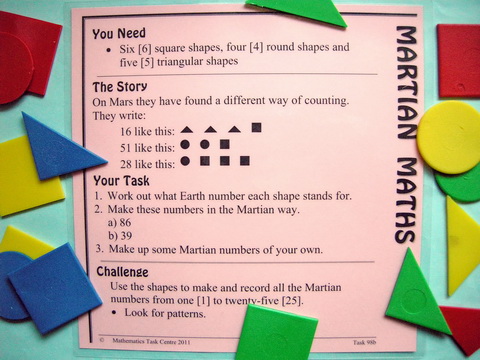
Martian MathsTask 98 ... Years 4 - 8SummaryStudents are presented with 'hieroglyphics' based on simple shapes and are challenged to work out the number system being used. Then they apply their system to represent new numbers.
|
MaterialsTask 98a
Content
|

IcebergA task is the tip of a learning iceberg. There is always more to a task than is recorded on the card. |
There are two versions of this task simply to make best use of the way the pieces are supplied from the manufacturer. Check the number in the bottom right hand corner of the card to determine which solution below is appropriate in your case. 98a 98b Note: Answers given are the most efficient in that they use the least number of pieces. However other solutions are possible and not wrong because we have not been informed of the martian rules for using the symbols. However, this is certainly an opportunity to discuss why efficient use of the symbols might be useful. How many ways could the Martians find to make 39? Record as many as you can.Extensions
|
Whole Class InvestigationTasks are an invitation for two students to work like a mathematician. Tasks can also be modified to become whole class investigations which model how a mathematician works. |
Shapes such as those used in the task are fairly easy to find. You only need enough of three different types and it doesn't really matter what they are. Check the art room. There are always interesting things that the art teacher has sourced from many and various places. Make up bags of shapes for each pair and use the card and the information above to direct the investigation. There is a rich unit on number systems that could develop from this starting point. At this stage, Martian Maths does not have a matching lesson on Maths300. However, lessons related to number systems are:
For more ideas and discussion about these investigation, open a new browser tab (or page) and visit Maths300. |
Is it in Maths With Attitude?Maths With Attitude is a set of hands-on learning kits available from Years 3-10 which structure the use of tasks and whole class investigations into a week by week planner. |
The Martian Maths task is an integral part of:
|